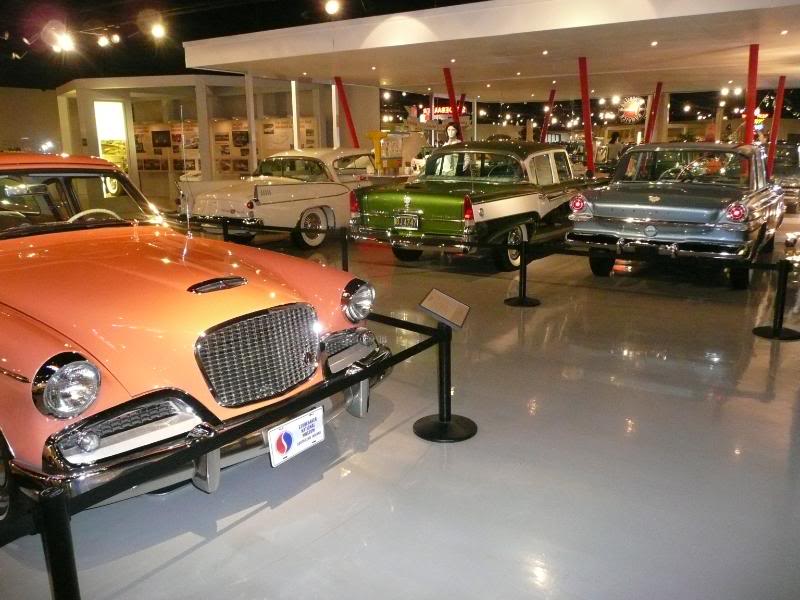South Bend, Indiana is probably now best known, at least in the US, as the home of the University of Notre Dame, an establishment renowned for its sporting prowess. However, go back a little further in history, and it was home to the Studebaker.
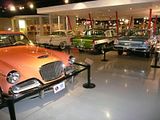
Like many car manufacturers, the origins of the company pre-date the car by some considerable time. In the case of Studebaker, two brothers, Henry and Clement, opened a blacksmiths shop in South Bend, IN, in 1852. In their first year of operation, they built two horse-drawn farm wagons. The following year, they built a further wagon, which their younger brother, John, provided to a wagon train as payment for passage to the Gold Fields of California. John made a lot of money in the next few years, making wheelbarrows and other tools for the miners in California, which he then invested in his brother’s business upon his return to South Bend, in 1858. Business continued to boom, and soon the Studebaker Brothers Manufacturing Company was the largest producer of horse-drawn vehicles in the world. Among other customers, they supplied horse drawn carriages to the President of the USA, as these 2 examples show. The first was built for Ulysses S Grant, and dates from 1873, and the second for McKinley, dating from 1896.
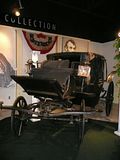
 This Phaeton from 1857 is typical of the products that were generating all the money:
This Phaeton from 1857 is typical of the products that were generating all the money: Studebaker entered the automotive business in 1902, when they produced an electric car. Unconvinced at the time of the merits of the gasoline engine, it was a further 2 years before their first petrol car was produced, the Model A. Like many early automotive companies of the time, new models came thick and fast as demand for this new type of transport increased. This car is believed to be the oldest surviving petrol engined Studebaker, a Model C from 1904.
Studebaker entered the automotive business in 1902, when they produced an electric car. Unconvinced at the time of the merits of the gasoline engine, it was a further 2 years before their first petrol car was produced, the Model A. Like many early automotive companies of the time, new models came thick and fast as demand for this new type of transport increased. This car is believed to be the oldest surviving petrol engined Studebaker, a Model C from 1904. This Electric Runabout dates from 1911:
This Electric Runabout dates from 1911: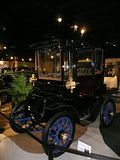 At this time, they were still producing a variety of horse-drawn equipment as well, and this sleigh, dating from 1905, was praised as a quality product in its day:
At this time, they were still producing a variety of horse-drawn equipment as well, and this sleigh, dating from 1905, was praised as a quality product in its day: Farm equipment production continued until 1920, thus making this 1920 wagon among the last so produced.
Farm equipment production continued until 1920, thus making this 1920 wagon among the last so produced.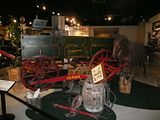 In 1911, the Studebaker Brothers Maunfacturing Company merged with the Everitt-Metzger-Flanders Company of Detroit, to form the Studebaker Corporation. This new organisation was still making both electric and petrol powered vehicles. This Flanders 20 model dates from 1912.
In 1911, the Studebaker Brothers Maunfacturing Company merged with the Everitt-Metzger-Flanders Company of Detroit, to form the Studebaker Corporation. This new organisation was still making both electric and petrol powered vehicles. This Flanders 20 model dates from 1912.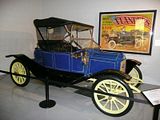 In 1913, a new range of cars was introduced, consisting of 4 and 6 cylinder vehicles, all simply branded “Studebaker”. The company became the third largest maker of vehicles in America, smaller only than Ford and Overland. At this time, manufacture was concentrated in Detroit, but once they ceased to make horse-drawn equipment, in 1920, production was centred on South Bend.A 1913 E6 Touring Model:
In 1913, a new range of cars was introduced, consisting of 4 and 6 cylinder vehicles, all simply branded “Studebaker”. The company became the third largest maker of vehicles in America, smaller only than Ford and Overland. At this time, manufacture was concentrated in Detroit, but once they ceased to make horse-drawn equipment, in 1920, production was centred on South Bend.A 1913 E6 Touring Model: Also from 1913, a Model 25 Touring:
Also from 1913, a Model 25 Touring: This SF-Four Roadster dates from 1916:
This SF-Four Roadster dates from 1916: Also from 1916, is this Six Coupe
Also from 1916, is this Six Coupe During the 1920s, Studebaker continued to prosper, with a growing range of cars aimed at the increasing numbers of middle-class Americans who could now afford personal mobility. The 1920 Light Six Model:
During the 1920s, Studebaker continued to prosper, with a growing range of cars aimed at the increasing numbers of middle-class Americans who could now afford personal mobility. The 1920 Light Six Model: In 1927, the first highway crossing America was completed. The Lincoln Highway stretched from New York to San Francisco, and to prove the durability of their cars, Studebaker set about driving as fast as they could – not easy given the state of the roads and the paucity of fuel stations – from New York. This was the car in which this epic journey was undertaken:
In 1927, the first highway crossing America was completed. The Lincoln Highway stretched from New York to San Francisco, and to prove the durability of their cars, Studebaker set about driving as fast as they could – not easy given the state of the roads and the paucity of fuel stations – from New York. This was the car in which this epic journey was undertaken: Buoyed by the success of this, a further longevity trial was completed in 1928, with this car completing 25,000 miles in just under 23,000 minutes
Buoyed by the success of this, a further longevity trial was completed in 1928, with this car completing 25,000 miles in just under 23,000 minutes Also in 1927, Studebaker replaced the generic model names such as “Big Six”, “Light Six” etc with the far more imposing sounding “President”, “Commander” and “Dictator”. On the left, a 1932 President Convertible Coupe, to the right, a 1927 President Limousine
Also in 1927, Studebaker replaced the generic model names such as “Big Six”, “Light Six” etc with the far more imposing sounding “President”, “Commander” and “Dictator”. On the left, a 1932 President Convertible Coupe, to the right, a 1927 President Limousine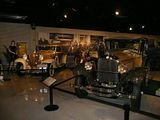
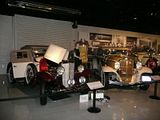 A 1927 President Limousine:
A 1927 President Limousine: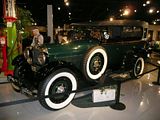 This is a 1931 President 4 Seasons Roadster:
This is a 1931 President 4 Seasons Roadster: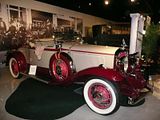 In 1928, Studebaker purchased the Pierce Arrow company, a Buffalo, NY organisation, known for producing luxury cars. However, the then president of Studebaker then massively underestimated the extent of the Great Depression, and in 1933, the company went into receivership. 2 of the Vice Presidents, Paul Hoffman and Harold Vance were elected to run the company, and they did manage to rescue it, but the momentum was lost and Studebaker never recovered to the position of strength that they had enjoyed prior to 1929. In 1933, they had to sell the Pierce Arrow organisation, and they also dropped the Rockne, a small car that they had launched in 1932, named in honour of Knute Rockne, a famed football coach at Notre Dame. During the 1930s, Studebaker introduced several new models, including the streamlined Land Cruiser, a name that they would use on and off until the end of the company in 1966.
In 1928, Studebaker purchased the Pierce Arrow company, a Buffalo, NY organisation, known for producing luxury cars. However, the then president of Studebaker then massively underestimated the extent of the Great Depression, and in 1933, the company went into receivership. 2 of the Vice Presidents, Paul Hoffman and Harold Vance were elected to run the company, and they did manage to rescue it, but the momentum was lost and Studebaker never recovered to the position of strength that they had enjoyed prior to 1929. In 1933, they had to sell the Pierce Arrow organisation, and they also dropped the Rockne, a small car that they had launched in 1932, named in honour of Knute Rockne, a famed football coach at Notre Dame. During the 1930s, Studebaker introduced several new models, including the streamlined Land Cruiser, a name that they would use on and off until the end of the company in 1966.
 A 1935 Commander Land Cruiser:
A 1935 Commander Land Cruiser: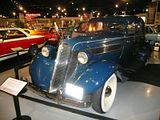 A 1936 President Model:
A 1936 President Model:
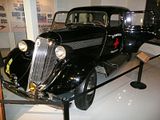 This design dates from 1935:
This design dates from 1935: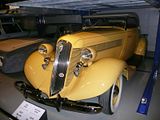 It was also at this time that they made a concerted effort to get into the commercial truck segment, introducing a line of cab-over engine trucks. In 1937, the very radical and smoothly contoured Coupe Express pickup premiered. Studebaker continued to make a range of trucks until December 1963. This one dates from 1947:
It was also at this time that they made a concerted effort to get into the commercial truck segment, introducing a line of cab-over engine trucks. In 1937, the very radical and smoothly contoured Coupe Express pickup premiered. Studebaker continued to make a range of trucks until December 1963. This one dates from 1947:
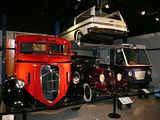 This car, the Bendix, dates from 1938:
This car, the Bendix, dates from 1938: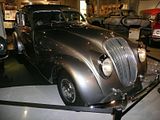 It was not all bad news, though, and in 1939, an advanced small car, the Champion was premiered. This was an instant success, and sold in far larger volumes than had been expected. After the cessation of hostilities, Studebaker resumed car production, and they were the first established car company to launch a car with all-new styling, which they did in 1947.
It was not all bad news, though, and in 1939, an advanced small car, the Champion was premiered. This was an instant success, and sold in far larger volumes than had been expected. After the cessation of hostilities, Studebaker resumed car production, and they were the first established car company to launch a car with all-new styling, which they did in 1947.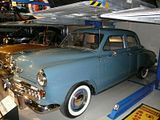 In 1950, they came up with a more radical new look, a bullet-shaped front end, intended to ressemble the front of an airplane. This car, the Champion Starliner was the mainstay of the range.
In 1950, they came up with a more radical new look, a bullet-shaped front end, intended to ressemble the front of an airplane. This car, the Champion Starliner was the mainstay of the range. In 1952, it was facelifted, and toned-down somewhat to look like this:
In 1952, it was facelifted, and toned-down somewhat to look like this: In 1938, Studebaker had engaged the services of Raymond Loewy, who took charge of design. Loewy assembled a team of very talented designers, which included Virgil Exner, Gordon Buehrig and Robert Bourke. It was this latter who was credited with the design for the 1953 Champion Starliner and Starlight coupes, still believed by many to be among the most beautiful American cars ever made.
In 1938, Studebaker had engaged the services of Raymond Loewy, who took charge of design. Loewy assembled a team of very talented designers, which included Virgil Exner, Gordon Buehrig and Robert Bourke. It was this latter who was credited with the design for the 1953 Champion Starliner and Starlight coupes, still believed by many to be among the most beautiful American cars ever made. This line of cars evolved over the next few years. In 1956 the car was rebranded as the Hawk, and in 1957, a very limited run of Golden Hawk 400s were made, such as this one.
This line of cars evolved over the next few years. In 1956 the car was rebranded as the Hawk, and in 1957, a very limited run of Golden Hawk 400s were made, such as this one.
 This model continued in production for several more years. This is a 1961 model, in the very unusual colour of “Flamingo”, unique to this car and the Lark Convertible.
This model continued in production for several more years. This is a 1961 model, in the very unusual colour of “Flamingo”, unique to this car and the Lark Convertible.
 In 1954, the Studebaker Corporation and the Packard Corporation joined forces. The combined organisation, however, found it increasingly difficult to compete with the Big Three (GM, Ford and Chrysler), and between 1954 and 1958 did not return a profit. Because of this, the Packard line ceased in 1958, having suffered the indignity of its final two years offering Studebaker products with Packard badges. In 1956, this rather dramatic car, the Packard Predictor was produced for the motor show circuit, to illustrate how cars could evolve.
In 1954, the Studebaker Corporation and the Packard Corporation joined forces. The combined organisation, however, found it increasingly difficult to compete with the Big Three (GM, Ford and Chrysler), and between 1954 and 1958 did not return a profit. Because of this, the Packard line ceased in 1958, having suffered the indignity of its final two years offering Studebaker products with Packard badges. In 1956, this rather dramatic car, the Packard Predictor was produced for the motor show circuit, to illustrate how cars could evolve. There had been numerous new products during this time. In 1956, a new President model appeared.
There had been numerous new products during this time. In 1956, a new President model appeared.
 In 1958, Studebaker took the brave decision to augment their range with the introduction of a stripped out low-cost model, the Scotsman.
In 1958, Studebaker took the brave decision to augment their range with the introduction of a stripped out low-cost model, the Scotsman. This car was such a success that they decided to base their future strategy off this approach and so all models apart from the Golden Hawk were dropped for 1959, to replaced by the Lark, a compact car. The Lark was instantly successful, and Studebaker posted their highest one year profit in 1959. However, the Big Three all fought back and launched their own Compacts in 1960, and were able to undercut the Studebaker, so the company found itself again fighting for survival. The Lark spawned a complete range of cars: 2 and 4 door saloons, a coupe, an estate, a convertible, and it was also used as the basis for some of the commercial vehicle offerings of the time.
This car was such a success that they decided to base their future strategy off this approach and so all models apart from the Golden Hawk were dropped for 1959, to replaced by the Lark, a compact car. The Lark was instantly successful, and Studebaker posted their highest one year profit in 1959. However, the Big Three all fought back and launched their own Compacts in 1960, and were able to undercut the Studebaker, so the company found itself again fighting for survival. The Lark spawned a complete range of cars: 2 and 4 door saloons, a coupe, an estate, a convertible, and it was also used as the basis for some of the commercial vehicle offerings of the time.
 The Lark was developed over the next few years, with a substantial facelift for 1963:
The Lark was developed over the next few years, with a substantial facelift for 1963: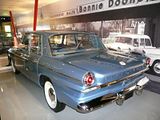 Having become the mainstay of the range, Studebaker added new models such as the Cruiser and the Daytona. They also introduced a real innovation to the estate car, the Wagonaire, with a sliding glass roof area over the luggage space, allowing for taller items to be carried. Sadly, they never quite got the sealing to work, and the car did not sell particularly well.
Having become the mainstay of the range, Studebaker added new models such as the Cruiser and the Daytona. They also introduced a real innovation to the estate car, the Wagonaire, with a sliding glass roof area over the luggage space, allowing for taller items to be carried. Sadly, they never quite got the sealing to work, and the car did not sell particularly well.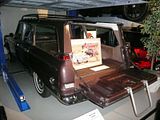 This prototype, dating from 1962, never did make production:
This prototype, dating from 1962, never did make production: In 1963, a very advanced sports coupe was premiered, the Avanti. Although the Avanti has lived on more or less ever since, it proved too late to save Studebaker, and 2 weeks before Christmas 1963, the company announced that it would cease production at the South Bend plant.
In 1963, a very advanced sports coupe was premiered, the Avanti. Although the Avanti has lived on more or less ever since, it proved too late to save Studebaker, and 2 weeks before Christmas 1963, the company announced that it would cease production at the South Bend plant. This car, a 1964 model Daytona is the very last to leave the South Bend works.
This car, a 1964 model Daytona is the very last to leave the South Bend works.
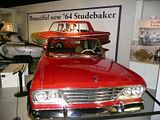 Production was transferred to Hamilton, in Ontario in Canada, a much smaller assembly plant that had been in use for a while. The end came on the 17 March 1966, when this car, a 2 door Daytona Lark came down the line.
Production was transferred to Hamilton, in Ontario in Canada, a much smaller assembly plant that had been in use for a while. The end came on the 17 March 1966, when this car, a 2 door Daytona Lark came down the line. That’s not quite the end of the story. Studebaker had acquired various other subsidiaries, and in mid 1967 they purchased the Wagner Electric Corporation, followed by a merger in November 1967 with the Worthington Corporation. This combined entity, the Studebaker-Worthington Corporation was absorbed by McGraw Edison in 1979. McGraw Edison themselves were acquired by Cooper Industries of Texas in April 1985. Rights to the Avanti – which had ceased production with the move to Canada, in 1964 – were acquired in 1965 by the newly formed Avanti Motor Corporation, and production resumed, using the original Studebaker moulds, but with a Corvette engine. Between 1982 and 2000, the Avanti Motor Corporation went through several changes of ownership and production locations. They experimented with various new models including a 4 door, a long wheel base coupe and a convertible. The cars are still produced in very limited numbers.
That’s not quite the end of the story. Studebaker had acquired various other subsidiaries, and in mid 1967 they purchased the Wagner Electric Corporation, followed by a merger in November 1967 with the Worthington Corporation. This combined entity, the Studebaker-Worthington Corporation was absorbed by McGraw Edison in 1979. McGraw Edison themselves were acquired by Cooper Industries of Texas in April 1985. Rights to the Avanti – which had ceased production with the move to Canada, in 1964 – were acquired in 1965 by the newly formed Avanti Motor Corporation, and production resumed, using the original Studebaker moulds, but with a Corvette engine. Between 1982 and 2000, the Avanti Motor Corporation went through several changes of ownership and production locations. They experimented with various new models including a 4 door, a long wheel base coupe and a convertible. The cars are still produced in very limited numbers.2009-12-28 11:31:42



















































